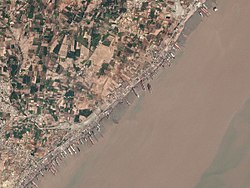






A ship graveyard, ship cemetery or breaking yard is a location where the hulls of scrapped ships are left to decay and disintegrate, or left in reserve. Such a practice is now less common due to waste regulations and so some dry docks where ships are broken (to recycle their metal and remove dangerous materials like asbestos) are also known as ship graveyards.
Contents
By analogy, the phrase can also refer to an area with many shipwrecks which have not been removed by human agency, instead being left to disintegrate naturally. These can form in places where navigation is difficult or dangerous (such as the Seven Stones, off Cornwall, or Blackpool, on the Irish Sea); or where many ships have been deliberately scuttled together (as with the German High Seas Fleet at Scapa Flow); or where many ships have been sunk in battle (such as Ironbottom Sound, in the Pacific). Such regions are also likely to be described as shipwreck graveyards. [1]
The majority of the ships in the world are constructed in the developed countries. Ships last about 25–30 years, after which they become too expensive to maintain and are sold to be broken down. Most of them are directly sold to the ship recycling companies in India, Bangladesh, Pakistan and other developing countries, also known as the (semi-)periphery countries from Immanuel Wallerstein's World System Theory. In 2014, 54 percent of the ships went to the beaches of India and Bangladesh. [2] This is consistent with the period 2012–2018. From the total of 6,702 scrapped ships worldwide, 3,586 ships have been scrapped in India and Bangladesh, which comes down to 53.5 percent. [3]
As of January 2020, with 30% share India has the highest global revenue and highest share of global ship breaking (number and volume of ships broken). [4]
It is estimated that ship breaking yards provide more than 100,000 jobs to people worldwide and that they yield millions of tons of steel every year with a minimal consumption of electricity. [5] Besides steel, this industry also yields a huge amount of solid wastes in the form of scrapped wood, plastic, insulation material, glass wool, sponge, waste paper, oiled rope and cotton waste. [6]